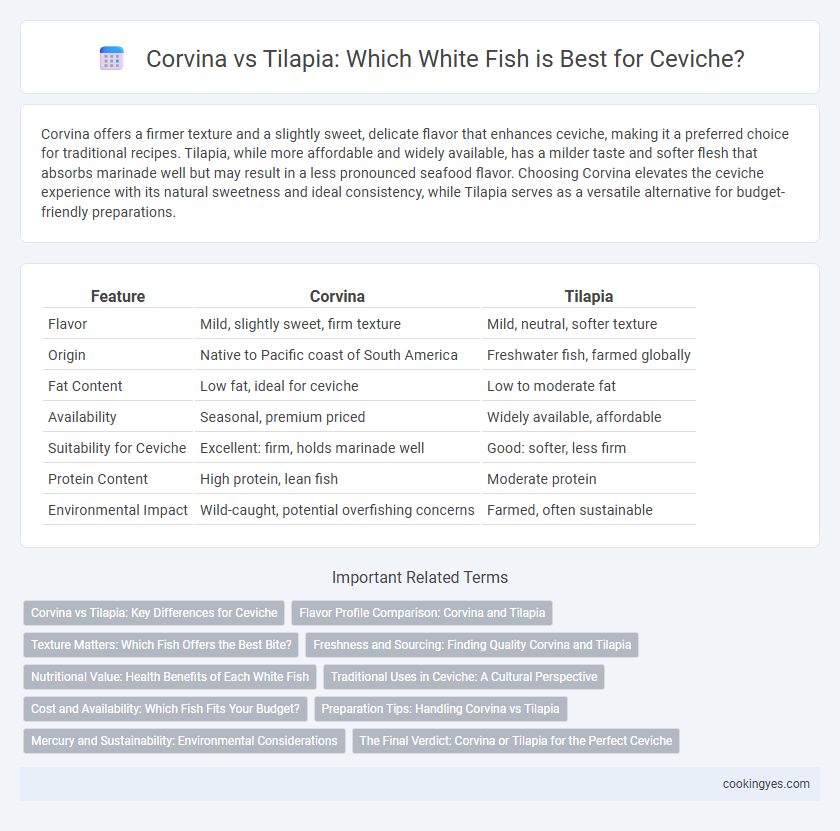Corvina offers a firmer texture and a slightly sweet, delicate flavor that enhances ceviche, making it a preferred choice for traditional recipes. Tilapia, while more affordable and widely available, has a milder taste and softer flesh that absorbs marinade well but may result in a less pronounced seafood flavor. Choosing Corvina elevates the ceviche experience with its natural sweetness and ideal consistency, while Tilapia serves as a versatile alternative for budget-friendly preparations.
Table of Comparison
| Feature | Corvina | Tilapia |
|---|---|---|
| Flavor | Mild, slightly sweet, firm texture | Mild, neutral, softer texture |
| Origin | Native to Pacific coast of South America | Freshwater fish, farmed globally |
| Fat Content | Low fat, ideal for ceviche | Low to moderate fat |
| Availability | Seasonal, premium priced | Widely available, affordable |
| Suitability for Ceviche | Excellent: firm, holds marinade well | Good: softer, less firm |
| Protein Content | High protein, lean fish | Moderate protein |
| Environmental Impact | Wild-caught, potential overfishing concerns | Farmed, often sustainable |
Corvina vs Tilapia: Key Differences for Ceviche
Corvina and Tilapia differ significantly in flavor and texture, impacting ceviche's final taste and mouthfeel; Corvina offers a firm, flaky texture with a mild, slightly sweet flavor ideal for authentic ceviche, while Tilapia has a softer, more delicate texture and a milder taste that can absorb citrus and spice but may lack depth. Corvina's natural firmness holds up better to the acid in ceviche, preventing the fish from becoming mushy, whereas Tilapia requires careful preparation to maintain structure. Choosing Corvina enhances the traditional ceviche experience with its balance of freshness and bite, while Tilapia serves as a budget-friendly alternative with a subtler profile.
Flavor Profile Comparison: Corvina and Tilapia
Corvina offers a delicate, slightly sweet flavor with a firm, flaky texture that enhances the fresh, citrusy notes in ceviche. Tilapia presents a milder, more neutral taste with a softer consistency, allowing the marinade to dominate the flavor profile. Choosing between corvina and tilapia depends on whether you prefer a distinct, natural fish flavor or a subtler base that absorbs seasoning.
Texture Matters: Which Fish Offers the Best Bite?
Corvina delivers a firm, flaky texture that holds up well in ceviche, providing a satisfying, slightly chewy bite. Tilapia has a softer, more delicate flesh that can become mushy when marinated, making it less ideal for traditional ceviche. Texture-wise, Corvina offers the best balance of tenderness and resilience for an authentic ceviche experience.
Freshness and Sourcing: Finding Quality Corvina and Tilapia
Choosing fresh Corvina or Tilapia for ceviche depends heavily on sourcing from reputable suppliers who prioritize sustainable fishing and proper handling. Corvina, often wild-caught along the Pacific coast, is prized for its firm texture and clean, mild flavor, provided it's purchased fresh and quickly chilled. Tilapia, commonly farm-raised, requires sourcing from certified farms with stringent quality controls to ensure freshness and prevent off-flavors, making freshness and traceability critical factors in selecting either fish for ceviche.
Nutritional Value: Health Benefits of Each White Fish
Corvina is rich in omega-3 fatty acids, promoting heart health and reducing inflammation, while also providing high-quality protein and essential minerals like selenium. Tilapia offers a lean protein source with lower fat content and a good amount of vitamin B12, supporting energy metabolism and nervous system function. Both white fish varieties contribute valuable nutrients, but Corvina's higher omega-3 content makes it a more beneficial choice for cardiovascular and anti-inflammatory health.
Traditional Uses in Ceviche: A Cultural Perspective
Corvina is traditionally favored in ceviche across Latin American coastal regions due to its firm texture and subtle, sweet flavor that complements the citrus marinade without overpowering it. Tilapia, although more widely available and affordable, is less common in authentic ceviche recipes because its softer flesh and milder taste can result in a less distinctive dish. Cultural practices emphasize the use of local, fresh corvina to maintain the ceviche's heritage and balance between acidity and seafood essence.
Cost and Availability: Which Fish Fits Your Budget?
Corvina typically costs more than tilapia due to its higher demand and limited availability in local markets, making tilapia a budget-friendly white fish option for ceviche. Tilapia's widespread farming and consistent supply ensure lower prices and easier access, ideal for those seeking an economical yet tasty ceviche base. Both fishes offer quality protein, but tilapia's affordability and availability often make it the preferred choice for cost-conscious ceviche recipes.
Preparation Tips: Handling Corvina vs Tilapia
Corvina offers a firm texture and mild flavor ideal for ceviche, requiring gentle slicing to maintain its integrity, while tilapia's softer flesh demands careful handling to prevent mushiness. To prepare corvina, chill the fish thoroughly before thinly slicing against the grain, ensuring clean cuts that absorb citrus marinade evenly. Tilapia should be patted dry and cut into slightly larger pieces to preserve texture, with minimal marination time to avoid over-softening the flesh.
Mercury and Sustainability: Environmental Considerations
Corvina typically contains lower mercury levels compared to tilapia, making it a safer option for ceviche consumption. Corvina is often sourced from more sustainable fisheries with better environmental practices, whereas tilapia farming can involve intensive aquaculture with potential ecological impacts like water pollution and habitat disruption. Choosing wild-caught corvina supports marine biodiversity and reduces ecological footprint relative to conventionally farmed tilapia.
The Final Verdict: Corvina or Tilapia for the Perfect Ceviche
Corvina offers a firm texture and slightly sweet, delicate flavor that holds up well to the citrus marinade, making it the preferred choice for authentic ceviche. Tilapia is milder and softer, absorbing flavors quickly but sometimes resulting in a less distinct taste and a more fragile bite. For the perfect ceviche, corvina's balance of flavor and texture delivers a vibrant, fresh experience that tilapia often cannot match.
Corvina vs Tilapia for white fish choice Infographic

 cookingyes.com
cookingyes.com